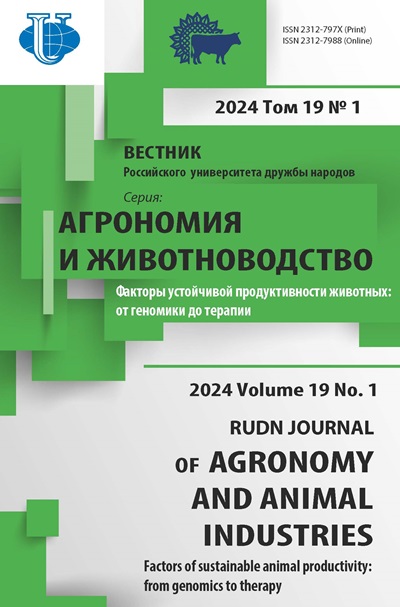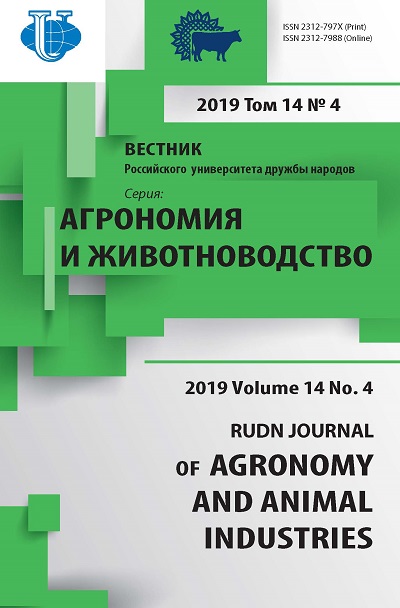Improving efficiency of chemical processing in strip-tilled row crops
- Authors: Meznikova M.V1, Borisenko I.B1, Ulybina E.I2, Boyarkina O.V3
-
Affiliations:
- Volgograd State Agricultural University
- Frolovo Industrial and Economic College
- Peoples’ Friendship University of Russia (RUDN University)
- Issue: Vol 14, No 4 (2019)
- Pages: 453-465
- Section: Soil science and agrochemistry
- URL: https://agrojournal.rudn.ru/agronomy/article/view/19530
- DOI: https://doi.org/10.22363/2312-797X-2019-14-4-453-465
Cite item
Full Text
Abstract
When growing crop products, it is important to use an integrated approach at the stages of planning technological operations and developing technical means for their implementation. In this case, the best result is achieved when coordinating operations on mechanical and chemical tillage, which provides for the protection and nutrition of plants. Along with this, it is important to consider following the applied technology to environmental principles, since agriculture directly affects the environment of our planet. Resource-saving technologies help preserve nature for future generations, restore natural fertility and take care of economic well-being. For row crops, the use of Strip-till technology is recommended. This requires 20...30% of all costs to direct to chemical treatment. Obviously, a decrease in the chemical effect on the soil during the transition to strip technology is necessary, and the introduced chemical should be redirected strictly to the target. A technical solution for the adaptation of serial sprayers is proposed, which consists of the use of strip spraying with the ability to accurately add and redistribute the working solution to the objects of influence, considering stage of plant development. This allows to reduce hectare application rates and stress of cultivated plants, and to save money on chemical processing. In addition, it also helps to solve environmental problems by reducing the chemical load on the soil. The proposed approach and technical solution make it possible to supplement the complex of machines for mechanical tillage in the framework of strip technology and reduce the chemical load on the biosphere.
About the authors
Marina V Meznikova
Volgograd State Agricultural University
Author for correspondence.
Email: marina_roxette@mail.ru
Associate Professor, Department of Life Safety
Volgograd, RussiaIvan B Borisenko
Volgograd State Agricultural University
Email: boris-enivan@yandex.ru
Doctor of Technical Sciences, Senior Researcher, Department of Agriculture and Agricultural Chemistry
Volgograd, RussiaEkaterina I Ulybina
Frolovo Industrial and Economic College
Email: ulibina.ekat@yandex.ru
Lecturer
Volgograd region, RussiaOlga V Boyarkina
Peoples’ Friendship University of Russia (RUDN University)
Email: boyarkina-ov@rudn.ru
Technician, Laboratory for Experimental Remote Sensing and Monitoring of Land Resources
Moscow, RussiaReferences
- Zavrazhnov AI, Balashov AV, Djyachkov SV, Omarov AN, Strygin SP. Determination of design parameters of applicators for local processing of sugar beet crops. Achievements of Science and Technology of AIC. 2017; 31(1):52-55. (In Russ).
- Borisenko IB, Shaprov MN, Dotsenko AE, Borisenko PI. Technology of basic soil cultivation and implements used in root crops production. Izvestia Orenburg State Agrarian University. 2015; (6):76-79. (In Russ).
- Medvedev GA, Ekaterinicheva NG, Chizhikov SA. Influence of the main treatment of soil on the yield of hybrids of sunflower in the subsona of the south chernozems of the Volgograd region. Proceedings of Nizhnevolzskiy agrouniversity complex: science and higher vocational education. 2019; (2):98-105. (In Russ). doi: 10.32786/2071-9485-2019-02-11
- Borisenko IB, Shaprov MN, Borisenko PI. Agrotechnical approaches in the design of the working body of the minimum tillage with a strip deepening. Proceedings of Nizhnevolzskiy agrouniversity complex: science and higher vocational education. 2013; (4):193-197. (In Russ).
- Canales E, Bergtold J, Williams J. Modeling the choice of tillage used for dryland corn, wheat and soybean production by farmers in Kansas. Agricultural and Resource Economics Review. 2018; 47(1):90-117. doi: 10.1017/age.2017.23
- Borisenko IB, Meznikova MV. Using the strip-till resource-saving technology in sorghum growing. Izvestia Orenburg State Agrarian University. 2015; (6):82-84. (In Russ).
- Zubarev YN. Green revolution - the factor of the progress of agriculture. Perm Agrarian Journal. 2014; (3):17-21. (In Russ).
- Jaskulska I, Gałęzewski L, Piekarczyk M, Jaskulski D. Strip-till technology - a method for uniformity in the emergence and plant growth of winter rapeseed (Brassica napus L.) in different environmental conditions of Northern Poland. Italian Journal of Agronomy. 2018; 13(3):194- 199. doi: 10.4081/ija.2018.981
- Balashov AV. Using a block-module unit for pre-inspecial soil processing. Science in the Central Russia. 2018; (1):14-20. (In Russ).
- Belenkov AI, Tyumakov AY, Sabo MU. Precision (coordinate) agriculture in the Russian State Agricultural University - Timiryazev Moscow Agricultural Academy: reality and prospects. Bulletin of Altai State Agraricultural University. 2015; (4):5-10. (In Russ).
- Mi GH, Wu DL, Chen YL, Xia TT, Feng GZ, Li Q, Shi DF, Su XP, Gao Q. The ways to reduce chemical fertilizer input and increase fertilizer use efficiency in maize in Northeast China. Scientia Agricultura Sinica. 2018; 51(14):2758-2770. doi: 10.3864/j.issn.0578-1752.2018.14.013
- Lukhmenev VP. Influence of fertilizers, fungicides and growth regulators on sunflower yields. Izvestia Orenburg State Agrarian University. 2015; (1):41-46. (In Russ).
- Borisenko IB, Chamurliev OG, Chamurliev GO, Meznikova MV. Efficiency estimation of striptill soil processing tecnology. RUDN Journal of Agronomy and Animal Industries. 2018; 13(3):194-206. doi: 10.22363/2312-797X-2018-13-3-194-206
















